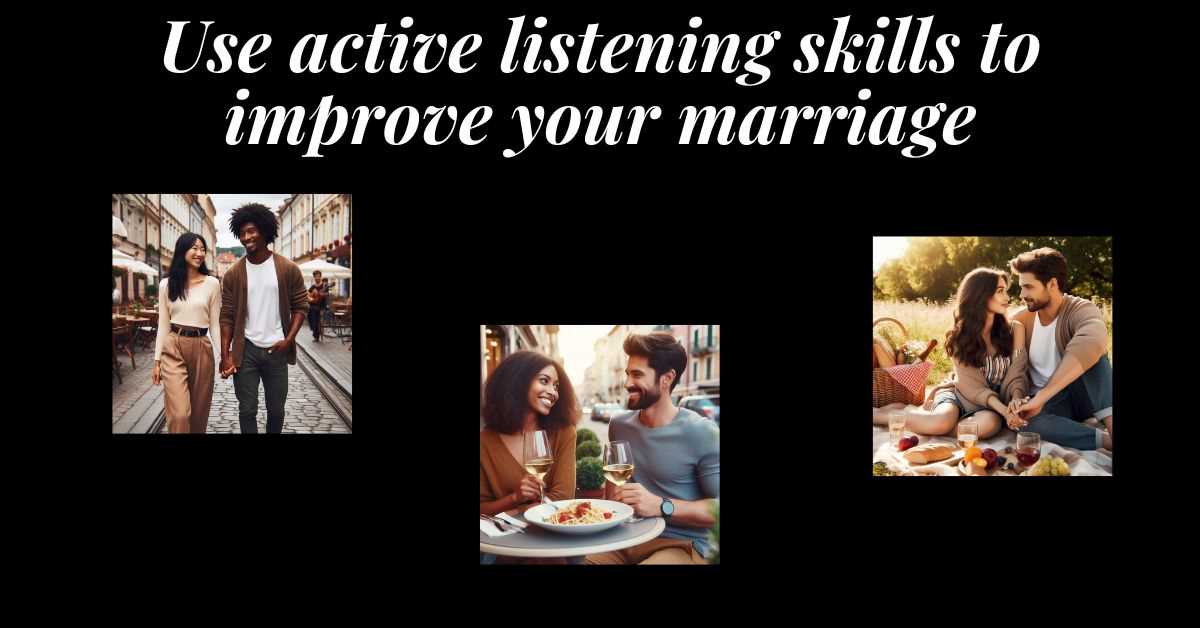How to Use Active Listening Skills to Improve Your Marriage Communication: A Step-by-Step Guide for Couples
Communication is one of the most important aspects of a healthy and satisfying marriage. It’s like the roots of your marriage and they feed everything else from your intimacy, your affection, and perception of each other.
But many couples, and especially us men, struggle with expressing their thoughts, feelings, needs, and desires to each other in a clear and constructive way. This of course, leads to distance between partners, disagreements and other conflicts.
the good things is that we can all learn and improve our communication skills and it’s not that hard to do.
In this article, I’ll share with you a step-by-step guide for couples who want to use active listening skills to improve their marriage communication. And just to make it super easy to remember and put to use, I broke each step into just 3 things to do that actually work.
The research done on active listening techniques has proven them to increase communication and understanding between partners.
Active listening is a communication skill that is essentially engaging our partner when they speak in a way that drives them to talk and express even more and it goes well beyond the simple listening techniques you may have read about.
Active listening skills include:
- Being fully present in the conversation
- Showing interest by practicing good eye contact
- Noticing (and using) non-verbal cues
- Asking open-ended questions to encourage further responses
- Paraphrasing and reflecting back what has been said
- Listening to understand rather than to respond
- Withholding judgment and advice
Active listening can help you and your partner communicate better, understand each other better, and resolve conflicts better. By following this guide, you will be able to enhance your relationship satisfaction, intimacy, and trust.
Step 1: Prepare to listen actively
Before you start a conversation with your partner, make sure you are ready to listen actively.
Having a genuine conversation requires us to be in a place physically and mentally where we can listen and engage in a real discussion.
And to do this isn’t difficult, in fact, there are 3 simple things to setting up a great talk that builds your relationship up.
Choosing the right time and place:
Pick a time and place when you and your partner are both calm, focused, and willing to talk. You can’t bring up sensitive topics when you or your partner are tired, hungry, stressed, distracted, or in public. That’s just asking for it to become an argument instead of a constructive talk. Instead find a place like at home in the evening where you can be alone, or maybe a quiet corner of a coffee shop or park.
Setting aside distractions:
Put away your phone, turn off the TV, close the door, or find a quiet spot. Make sure nothing will interrupt or distract you from listening to your partner. Making sure you can give each other your full attention is critical in having a good talk. Think about a time when you were talking with someone, and they checked a text. It made you feel like what you were talking about wasn’t that important to them didn’t it? And that’s why it’s so important to have a distraction free place to talk, so you both feel heard.
UW professor wrote his PhD research dissertation for the University of Connecticut on the effects of having a phone out during a conversation and found it produced a feeling of being snubbed or almost ignored by our partner.
Having an open mind:
Be willing to listen to your partner’s perspective, even if it differs from yours. Don’t assume you know what they are going to say or how they feel. This is something I have had to actively work on over the years. But it’s easy for us all to get ahead of what our partner is saying and to start injecting our own thoughts instead of actually listening to them. So just listen and let them speak even if you disagree. Listen and try to see their point of view or why they feel that way.

Step 2: Show interest in what your partner is saying
When your partner starts talking, you have to show them that you are interested in what they have to say.
One of the biggest parts of listening to someone is making them feel heard and listened to. It’s their perception of how they are being listened to that matters.
So how do you make them feel listened to and like you are truly interested and vested in what they have to say?
Making eye contact:
Look at your partner’s eyes when they speak. This shows that you are paying attention and that you care about their message. Eye contact instantly builds connection between people and it’s because when someone is looking into our eyes we can see and feel their interest in us.
Research from Dartmouth found that eye contact made significant affects on shared attention during a conversation. The study’s lead author stated in the study press release that,
“Eye contact is really immersive and powerful… When two people are having a conversation, eye contact signals that shared attention is high—that they are in peak synchrony with one another.”
Sophie Wohltjen
Using non-verbal cues:
Did you know your body language says more about how you’re listening to someone than your actual words? Our body language shows our partner just how interested we are or aren’t. Think when you’ve been talking and your partner is looking at other things or kicked back in their chair while you talk. It made you feel like they didn’t care right? But when you lean in, be alert and attentive to them it shows that you do care about them and what they have to say.
Giving verbal feedback:
Give them some sort of signal that tells them you are still listening while they are talking. This can be as simple as a “ya” or “ok” once in a while so that they don’t feel like they are just talking to themselves.
Related: This is the 30-day plan to better marriage communication forever
Step 3: Ask your partner questions
When your partner pauses or finishes speaking, that’s your time to push the conversation further by asking them questions.
This really goes to show them that not only are you paying attention and listening to them, but also interested in learning more. And that instantly makes them feel heard and more open to going deeper.
You can use this to lead into real deep conversations as well. Ask them about the future, about your future together and their hopes and goals for your relationship.
Asking open-ended questions:
Ask questions that invite your partner to elaborate or explain their thoughts and feelings. For example, you can ask “How did that make you feel?”, or “What do you want to do next?”. Open ended questions spur further discussion because they require an actual explanation which boosts all the good effects of step 2.
Asking specific probing questions:
Ask questions that help you clarify or confirm what your partner is saying. Think of questions like, you can ask “What do you mean by that?” or “Can you give me an example?”. These reenforce our interest and spur them into going into their own feelings more.
Research has found that probing questions build much more thorough understanding of what’s being communicated by our partner.
Avoiding yes/no questions:
Avoid asking questions that can be answered with a simple yes or no. These kill conversation because they act like a mental stop sign. Once the question is answered there’s nothing else to reflect on or go deeper into, it’s just done.

Step 4: Paraphrase and reflect
When your partner answers your questions or shares more information, paraphrase and reflect back what they have said. This doesn’t mean become a parrot and mimic or repeat what they are saying.
Think of it more as every once in a while, when they’ve made some overall points, sum up what you got from it.
This is kind of like rolling the first 3 steps together into one action to push the conversation even deeper, and there’s 3 simple ways to do it.
Summarizing their main points:
Repeat the main points of what your partner has said in your own words. But don’t just repeat it, put together your own idea about it so that they see not only did you hear them, but you actually understood them.
Expressing empathy:
Show that you understand how your partner feels by using empathic statements. These statements start with “It sounds like…” or “You seem…” followed by an emotion word like, “It sounds like you are frustrated”. This leads into what becomes the next point, validating their feelings and it starts to begin building up the bonds of intimacy between you.
Validating their feelings:
Show that you accept and respect how your partner feels by using validating statements. These statements like, “I can see why you are angry” or “It makes sense that you are sad”. They show your compassion and empathy towards them and validates what they’ve said to you.
Step 5: Listen to understand
When your partner is talking, listen to understand what they are trying to communicate.
This is different than just being there, hearing them talk. It’s listening and actively trying to take in and process what they are saying so that you truly understand them and how they feel.
This is how couples grow and evolve in their marriage, by truly knowing and understanding each other of different levels.
Asking yourself:
What is the main message that my partner is trying to convey what are their needs or goals in this situation, and how can I help them achieve them? These help you take in what they are saying and enable you to process it so you can help. Even if that’s just hearing them out.
Checking your understanding:
Ask your partner if you have understood them correctly bey saying things like “So, what you are saying is…” or “Am I right in thinking that…”. This not only shows your partner that you are interested, but it also avoids any miscommunications that could lead to a conflict later.
Showing appreciation:
Appreciation is like emotional fuel during a conversation or a stressful time and it’s a super easy way you can refuel your partner’s heart. For example, you can say “Thank you for telling me that”, “I appreciate your honesty”, or “I’m glad you opened up to me”. Little things like this let them know it is ok and good to have these deeper kinds of talks and from there you can really grow your relationship deeper.
And research has shown that us showing appreciation and gratitude affects others’ perception of us including how trustworthy we are withing the conversation.
Step 6: Withhold judgment and advice
Whenever your in a talk with your partner you must avoid making them feel any kind of judgement. Now don’t get me wrong, there are certainly things you need to make judgements over in marriage and you’ll naturally do so about every talk.
But the point is to not do so until after the talk.
Think of how you would feel if you were in the middle of pouring out your heart to someone and looked up to see they obviously thought you were stupid or had just gotten yourself into it and deserved it. The conversation stops there doesn’t it?
Instead, by making your partner feel like they aren’t being actively judged, it keeps them open and communicating.
No interrupting:
This is one that is a huge personal pet peeve of mine and many other men I have known feel the same way. When we are interrupted, we shut right down. It shows a total lack of interest, appreciation and respect. It’s essentially the opposite action of the first 3 steps here rolled into 1 single verbal move.
Not criticizing:
Don’t criticize your partner’s opinions or choices, remember that their feelings are valid even if they’re different than what you would’ve done. And remember that your body language again can say even more than your words. So, the eyerolls, judging faces and smirks have to be replaced with smiles and little laughs.
Research has found that criticism, even a minute one, creates distance between partners and during a conversation you want your partner to feel like you are being brought closer together.
Not giving advice:
How many times has someone been telling you about an issue and the solutions seem so obvious that you can’t help but point it out only for them to totally reject it and you for mentioning it? Yep, that happens because when the solution is thrown in our face like that it invalidates everything, we’ve gone through getting to that point. It’s like telling your partner that their struggles aren’t real in a sense.
Listen actively and build up your marriage
Active listening is a powerful communication skill that can improve your marriage communication and enhance your relationship.
By following this step-by-step guide, you will be able to practice active listening skills with your partner and show them that you care, understand, and support them.
So use these 6 steps to fuel your marriage communication and bring your relationship to a new level.
I really want to hear from you. Let me know in the comments about things you do that help push your marriage conversations to better and more open ways of talking.
Sign up for our free newsletter and get the latest articles, research, and great deals to keep your relationship growing.
You can find our latest articles below:
-

How the Presidential Election is Affecting Relationships
The election is just ramping up and with events like the attempted assassination, this election is affecting relationships like never before.
-

What to Do When Your Partner is Gaslighting in the Relationship
Gaslighting can make your relationship fall apart and bring your mental health with it. Here’s how to stop it before it starts.
-

How Men Gaslight Women in a Relationship
Gaslighting is something that can turn a good relationship into a living nightmare. Here’s how to recognize when it happens and what to do.
-

How Women Gaslight Men in a Relationship
Men, you need to be able to recognize when you are being gaslit by your woman. Here’s how and what to do about it to keep you safe and legal.
-

What is Gaslighting in a Relationship?
Gaslighting can turn a good relationship into a living hell, here’s what it is, and how to deal with it before the problems start.
-

Why Women Need to Start Approaching Men
Ladies you need to start approaching men and it is absolutely the #1 fastest way to catch that high quality man of your dreams.
